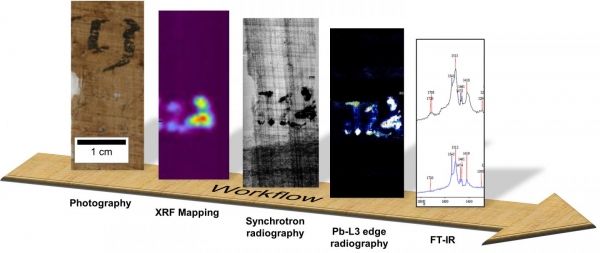The first thing that catches an archaeologist’s eye on the small piece of papyrus from Elephantine Island on the Nile is the apparently blank patch. Researchers from the Egyptian Museum, Berlin universities and Helmholtz-Zentrum Berlin have now used the synchrotron radiation from BESSY II to unveil its secret. This pushes the door wide open for analysing the giant Berlin papyrus collection and many more.
For more than a century, numerous metal crates and cardboard boxes have sat in storage at the Egyptian Museum and Papyrus Collection Berlin, all of which were excavated by Otto Rubensohn from 1906 to 1908 from an island called Elephantine on the River Nile in the south of Egypt, near the city of Aswan. Eighty percent of the texts on the papyrus in these containers have yet to be studied, and this can hardly be done using conventional methods anymore. Thousands of years ago, the Egyptians would carefully roll up or fold together letters, contracts and amulets to a tiny size so that they would take up the least possible space. In order to read them, the papyri would have to be just as carefully unfolded again. “Today, however, much of this papyrus has aged considerably, so the valuable texts can easily crumble if we try to unfold or unroll them,” Prof. Dr. Heinz-Eberhard Mahnke of Helmholtz-Zentrum Berlin and Freie Universität Berlin describes the greatest obstacle facing the Egyptologists, who are eager to unearth the scientific treasures waiting in the boxes and crates in the Berlin Egyptian Museum.
Testing the fragile papyrus with nondestructive methods
The physicist at Helmholtz-Zentrum Berlin knew from many years of research how to analyse the fragile papyrus without destroying it: shining a beam of X-ray light on the specimen causes the atoms in the papyrus to become excited and send back X-rays of their own, much like an echo. Because the respective elements exhibit different X-ray fluorescence behaviour, the researchers can distinguish the atoms in the sample by the energy of the radiation they return. The scientists therefore long ago developed laboratory equipment that uses this X-ray fluorescence to analyse sensitive specimens without destroying them.
Read more at: Helmholtz-Zentrum Berlin Für Materialien UND Energie
A team of researchers examined an ancient papyrus with a supposed empty spot. With the help of several methods, they discovered which signs once stood in this place and which ink was used. (Photo Credit: HZB)


